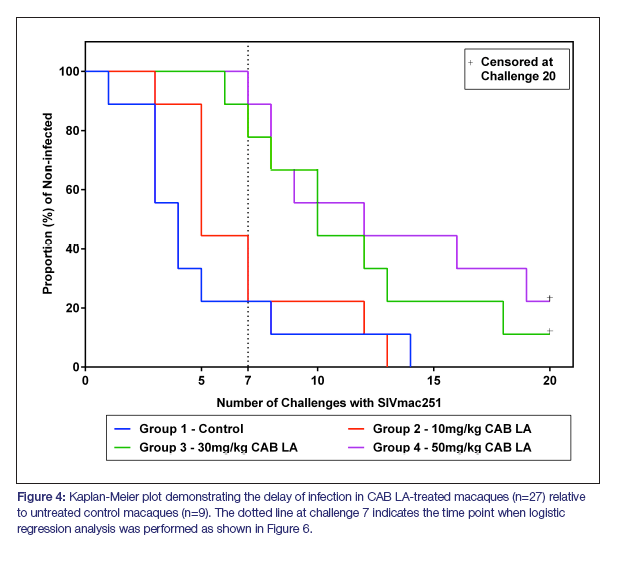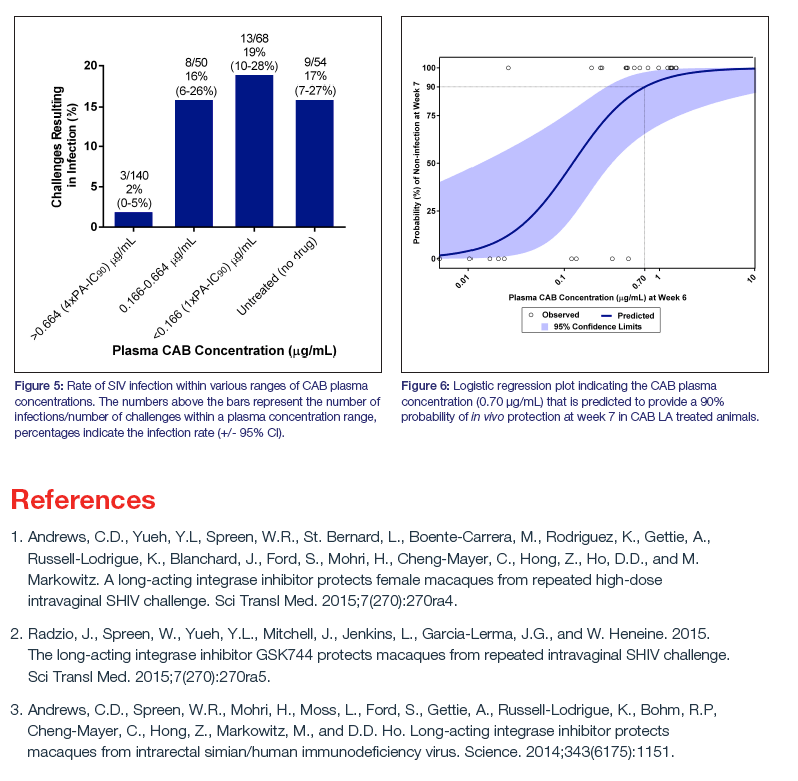 |
 |
 |
| |
CORRELATION OF IN VIVO CABOTEGRAVIR CONCENTRATION
& PREVENTION OF SIV IN MACAQUES
|
| |
| |
Reported by Jules Levin
CROI 2015 feb 23-26, Seattle, WA
William Spreen4, Anabel Lowry1, Ranajit Pal2, Yun Lan Yueh4, Susan Ford4,
Nicola Richardson-Harman3, Jim A. Turpin1, Fulvia Veronese1, James Cummins1, and ABL/BIOQUAL NHP Team
1Division of AIDS, National Institutes of Health (NIH), Bethesda, MD, United States, 2Advanced Bioscience Laboratories, Inc., Rockville, MD, United States, 3Alpha StatConsult LLC, Damascus, MD, United States, 4GlaxoSmithKline, Durham, NC, United States

Program abstract
Background: Previous studies with long-acting cabotegravir (CAB LA, GSK1265744) demonstrated protection against repeated intrarectal and intravaginal SHIV162p3 challenges in nonhuman primates. In one study, evaluation of the "window of protection" was performed using a single dose level of CAB LA in male macaques undergoing repeated intrarectal SHIV162p3 challenges. In order to determine if there is a relationship between the plasma drug concentration (as related to Protein Adjusted IC90, PA-IC90) and protection against intravaginal SIV transmission, we assessed plasma PK and longitudinal breakthrough infections in rhesus macaques following multi-exposure intravaginal challenge.
Methods: Twenty-seven Chinese rhesus macaques were injected intramuscularly with CAB LA at three dose levels (10, 30, and 50 mg/kg; n=9) at days -7 and -1 prior to initiation of weekly intravaginal SIVmac251 challenges (1000 TCID50). Nine untreated (i.e., no CAB LA injection) macaques served as virus controls. Macaques resisting infection after each weekly exposure were continually challenged for a maximum of 20 times and monitored for breakthrough infections. Plasma drug concentration measured by mass spectrophotometry and viral load measured by NASBA were monitored weekly until infection and then for an additional 16 weeks post infection.
Results: Significant protection from virus acquisition was noted in macaques dosed with 30 and 50 mg/kg CAB LA with a median of 9-11 challenges required for infection of drug-treated macaques compared to 3 (2-4 inter-quartile range) for untreated controls (P<0.05; Log rank analysis). There were no statistical differences between the 30 and 50 mg/kg doses for protection from infection or between the 10 mg/kg dose (median of 4 protected challenges) and the untreated controls. Analysis of plasma drug concentrations demonstrated a significant correlation between plasma CAB LA concentration and virus acquisition (P=0.0004). A CAB LA plasma concentration of 711 ng/mL (~4x PA-IC90) was predicted by logistic regression analysis to provide a 90% probability of in vivo protection after 7 SIV challenges.
Conclusions: These results may further elucidate the "window of protection" for cabotegravir and suggest that targeting 4x PA-IC90 in plasma may be sufficient to protect against vaginal SIV transmission in macaques, thus supporting a relationship between plasma drug concentration and in vivo efficacy.








|
| |
|
 |
 |
|
|